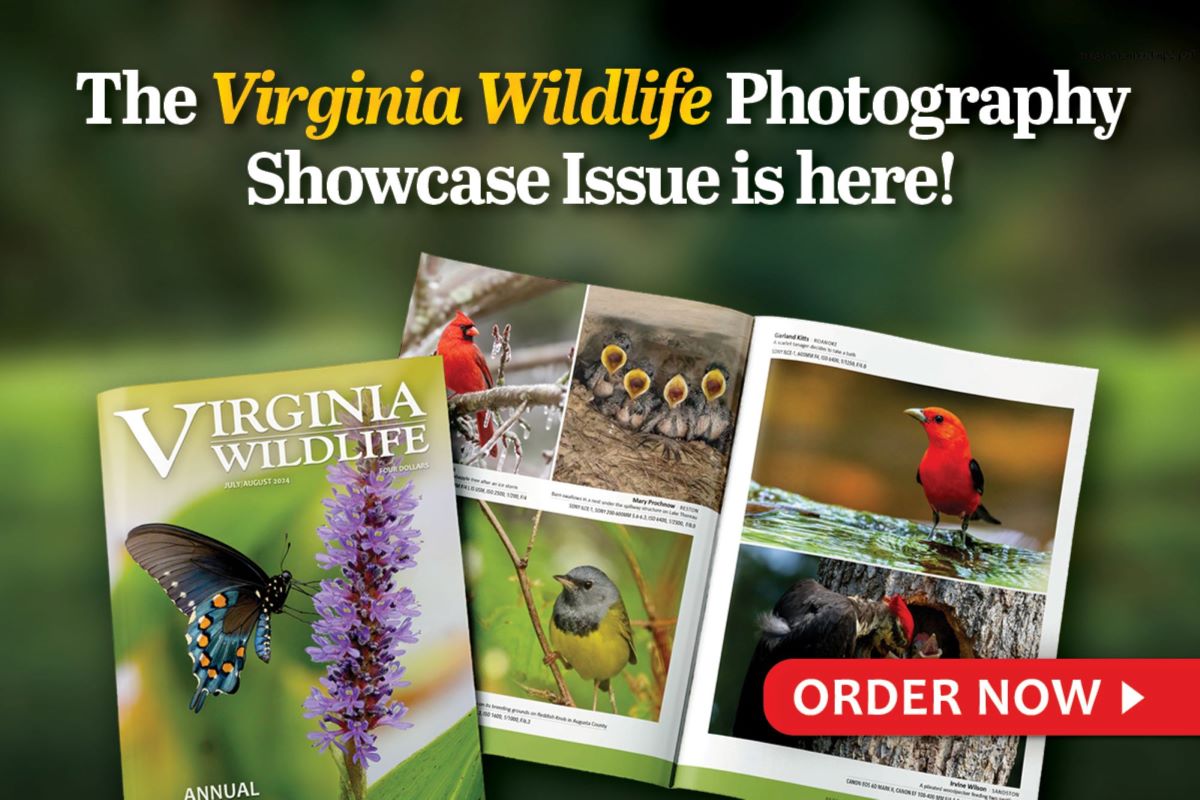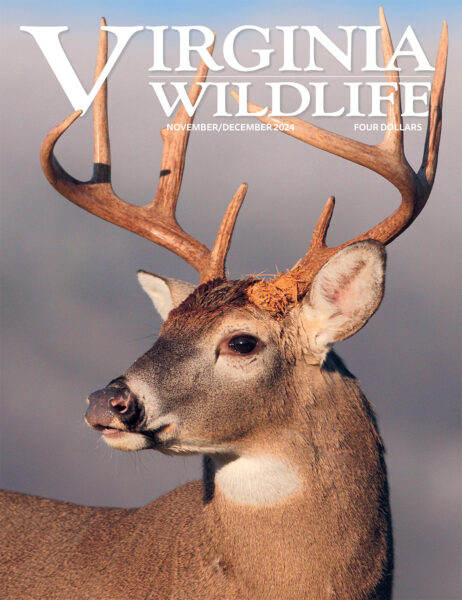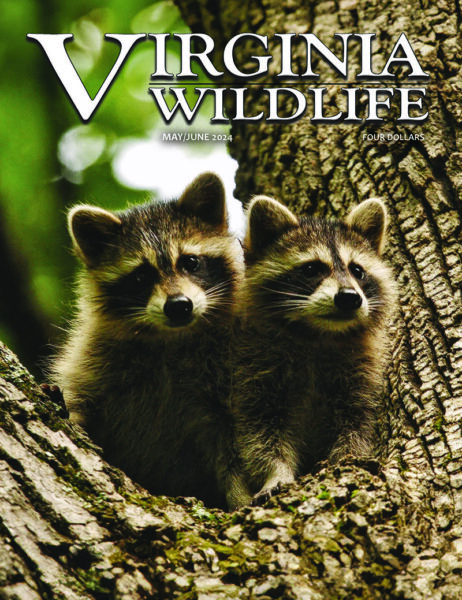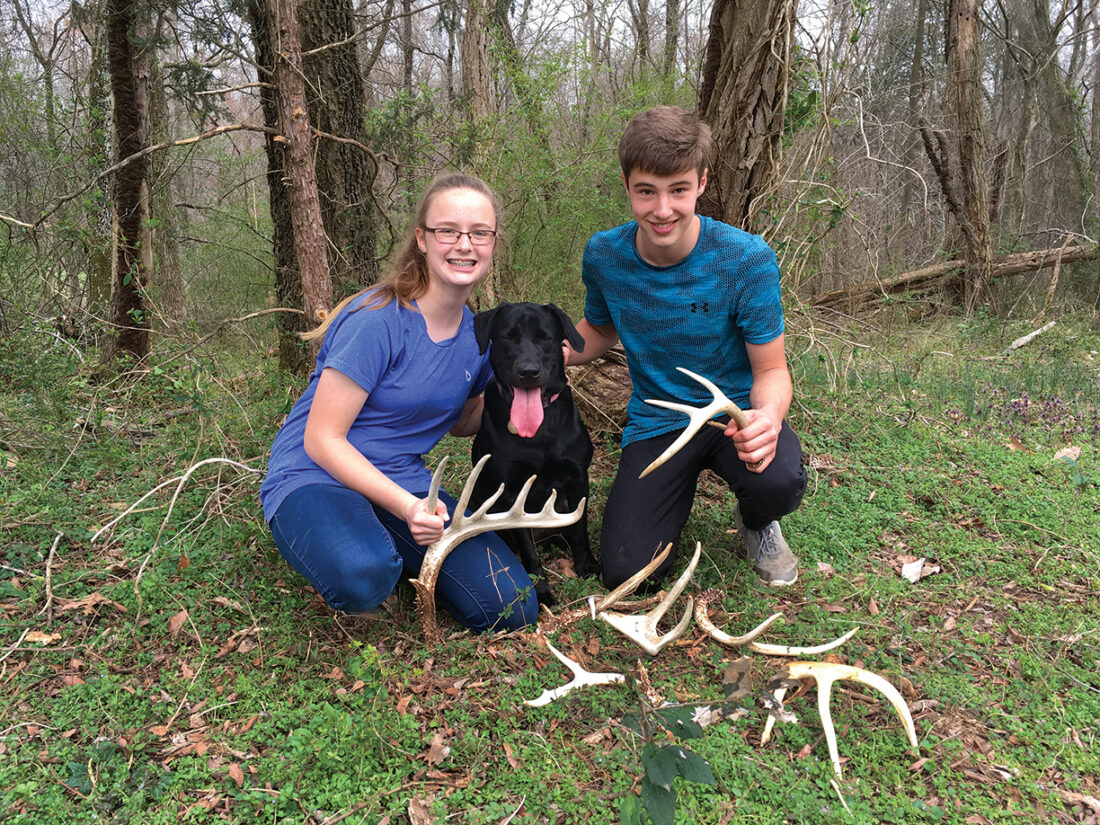
Finding shed antlers is a fun family activity for all involved. Photo by Brian Moyer DWR
By Gerald Almy
The buck’s long main beam and sweeping tines appeared to glow with their own inner light on that gray, rain-soaked day. Glassing carefully, I counted five points coming off the antlers.
It was an amazing rack.
But there was something different about this encounter from any other whitetail hunting experiences I’ve had in Virginia. It happened in March. And instead of glassing two sides of a rack protruding from a buck’s head, it was just one antler resting softly on a carpet of brown and tan oak leaves, left by a deer that no longer needed it.
Even though the buck no longer had a use for it, finding the shed antler brought a special joy to that late winter day. It said that this deer was still alive, walking these woods, and slowly starting the process of creating yet another set of antlers, ones that would most likely be larger and more impressive than the one I had just found.
If you’re feeling a bit let down after the close of deer season, it’s time to slip on your favorite hiking boots, grab a pair of binoculars, and go shed hunting.
Searching for cast-off deer antlers offers the perfect transitional activity to keep you engaged with wildlife and the great outdoors between fall deer hunting and spring turkey, and fishing seasons. It will teach you a lot, like how do deer grow antlers in the first place?
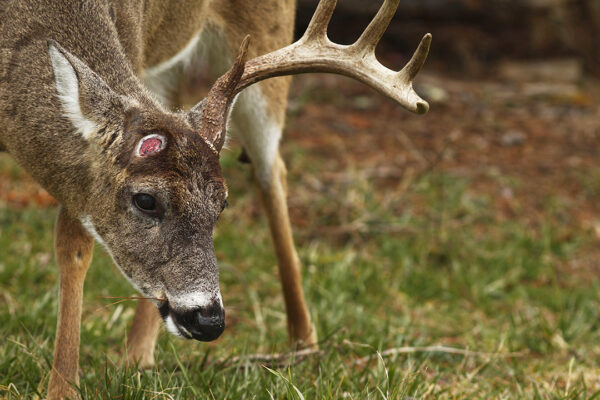
Once an antler has dropped off the pedicel, it heals over and the process begins again. Photo by Tommy Kirkland
Why Antlers Grow and Fall Off
Before it is born, a male deer will have formed two mounting points on the top of its skull called pedicels, a location for the outgrowth of frontal bone that eventually becomes antlers. Antlers start to grow from the tops of the pedicels in spring, and this growth is controlled by the photoperiod or day length, which in turn controls testosterone levels.
Starting with veins and arteries supplying nutrition, a protective skin called velvet forms over the emerging, living tissue that will eventually turn into true bone. After several months of rapid growth, the antlers are fully developed.
Around midsummer, increasing levels of testosterone triggered by the shortening day length causes the antlers to begin to ossify and turn into bone, which eventually cuts off the blood flow to the velvet. In Virginia, most bucks shed their velvet and molt to their winter coat between August 15 and September 15. The bucks are now ready for breeding season, the rut. At the end of the rut, a drop in testosterone levels causes weakness in the bone at the top of the pedicels thus causing the antlers to fall off anywhere, and anytime.
When to Look
Most deer in Virginia cast off their antlers sometime between January and March, though February and March are the prime months for “shedding.” But don’t wait too long because there are others searching for those antlers as well!
Antlers are a great source of calcium and phosphorous, which is a huge draw for many small mammals. If you wait too long, squirrels, chipmunks, groundhogs, and mice may gnaw away at the sheds damaging them. Start your search early if you want pristine antlers!
Why Should I Hunt for Sheds?
Hunting sheds offers wonderful opportunities to get outdoors for some fresh air and exercise! For one, it is a great excuse to invite family and friends out for a friendly shed “treasure” hunt. Even the family dog can join in.
Besides looking for antlers, you could also be scouring the woods for signs, especially if getting ready for the upcoming spring gobbler season. Be on the lookout for their distinctive droppings and scrapes.
If deer hunting is your focus, look for rubs, scrapes, tracks, droppings, and natural travel funnels. Also, take note of prime feeding and bedding areas. Information of this type can be invaluable for the next fall hunting season.
You could find a shed anywhere in a buck’s home range. But odds are good that 90 percent or more of the antlers you discover are going to be found in one of three locations: bedding areas, transition corridors, and feeding areas. Identifying and recording which of these areas you find a shed will help you formulate your fall hunting strategy.

Photo by Todd Pusser
Discovering Bedding Areas
Unless the shed is in a feeding area or along a travel route, chances are good you’ve found part of that deer’s core bedding territory. The thickest, most remote areas are the ones dominant, older bucks will claim. Overgrown swamps, conifer stands that block the wind and provide thermal protection, saddles in ridges, brushy hollows, creek bottoms, benches just down from ridges, and growing-back clear-cuts are the places to look for sheds left by bedding bucks. These are often the same spots that serve as escape areas for bucks if you hunt in high-pressure situations. Any time other than the rut, these are prime stand locations.
Finding Transition Routes
If you find a good shed and it’s not in a thick, jumbled or remote bedding type cover, chances are it’s on a transition route the deer uses from that daytime bedding cover to evening or nighttime feed areas. This is also a valuable discovery and can be a prime fall stand site.
Try to locate funnels or pinch points along these routes such as strips of timber between fields, saddles, or narrow stream bottoms. Using topo maps and aerial photos, unravel where that deer was moving from and where it was heading.
Locating Feeding Fields
When you locate a shed along a transition corridor, start looking downhill from there or toward more open fields and try to predict where the animal was heading to feed. This might be an acorn flat, orchard, area with herbaceous plants and browse, agricultural field, or food plot. Identifying that destination can help further in formulating your fall hunting plans. And chances are good you’ll find more sheds at the actual feeding site.
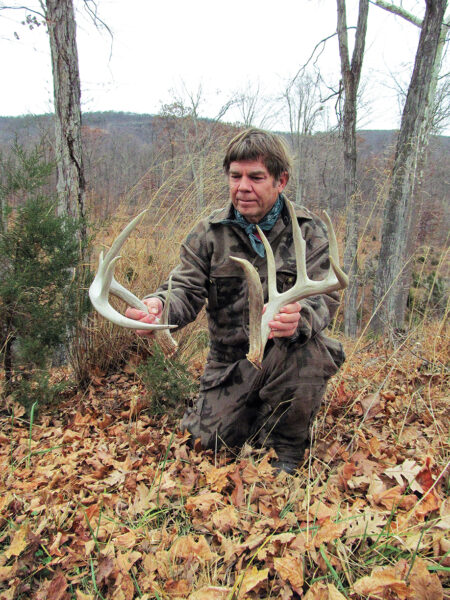
The author holds an amazing pair of sheds found walking the mountains near his home.
Record What You Find
To get the most out of shed hunting, keep thorough records of what you find on your forays. In a notebook, write down the antler’s circumference measurements, beam length, the number of points and age estimate, and take a photo. Record its location or mark it on a topographic map or sketch of the property so you have the exact spot pinpointed.
All of this can then be scoured over and analyzed before next fall to help you decide which bucks to pass on for another year or two, which ones to try for, and where the best ambush spot is to accomplish that goal.
Searching Tactics
The best method I’ve found for successful shed hunting is to try to work methodically in a grid pattern as you walk through the woods. That way you don’t overlook any habitat. Look for antler tines jutting up, the graceful curl of a buck’s main beam, or sun glinting off a rack.
Work parallel, walking along side hills or benches. Then move up 30-80 yards and work back the opposite direction.
If you work “up and down” you’ll waste a lot of energy. Years of grouse hunting in Virginia’s mountains taught me that! Also consider reworking through areas that look especially good or have produced sheds in the past. Approaching from a different angle may make the antler stand out more.
“Drives” are also a fun way to discover sheds. This method can be used when friends and/or relatives work as a team as if you were conducting a deer drive during hunting season. Your “treasure hunt” now becomes a social event, and everyone can share in the excitement when a shed is found.
Also consider bringing along the family pet—canines, not cats! Most dogs will enjoy the exercise and many become quite skilled at the activity with minimal training time. Just let him know you get the sheds, not him.
Other Productive Spots
Good spots to search for sheds include heavy cover near food plots, agricultural fields, swamps, conifer stands, brush-choked hollows, saddles in ridges, benches, draws, creek bottoms, and islands in rivers. Sometimes you’ll find sheds in cover so thick you can barely walk through it. Other times you’ll locate them easily in open feeding areas where the animals probably dropped them at night.
Areas that have been burned recently are great since the sheds literally jump out at you against the blackened background. South and southwest facing slopes are often productive since bucks like to soak up the rays of afternoon sun there.
You want to cover lots of ground, but this isn’t a race. It’s not how fast you walk, but how carefully you scour the ground. If you find one antler, search hard in the immediate area and you may find its match, but not necessarily. I’ve found one side of a rack and then discovered the other match days later and a mile away.
If you can, hunt during a light rain or on cloudy days. The antlers show up better then. When searching during bright, clear weather, keep the sun at your back and wear polarizing sunglasses.
What to Bring on a Shed Hunt
Three items I bring on every shed hunt are a walking stick, large daypack, and binoculars. A walking stick is self-explanatory. A day pack will give you something to carry water, snacks, and your found sheds. Binoculars let you quickly check out objects you see at a distance that might be sheds. More than once, these “objects” have turned out to be the best shed of the day.
It’s important to keep your hopes in check when you hunt for sheds. Don’t anticipate finding an armful of antlers. If you pick up two or three on a half-day outing, consider it a successful shed hunting expedition. Once you find your first deer antler, though, chances are you’ll make shed hunting a regular part of your outdoor activities to fill that “gap” between fall hunting and spring turkey and fishing seasons. Happy Hunting!
Author Gerald Almy lives in the Shenandoah Valley but travels widely for his work as a full-time outdoor writer. He is currently a columnist for Sports Afield and a contributing editor for Field & Stream.

This article originally appeared in Virginia Wildlife Magazine.
For more information-packed articles and award-winning images, subscribe today!
Learn More & Subscribe

